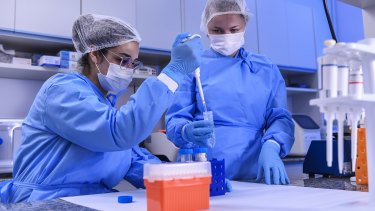As most people curtail their lives to follow the ever-tightening social distancing rules, the alarm bells about what lies ahead grow louder each day. While China offered the first glimpse of the human calamity the coronavirus can inflict on a nation, Italy has erased any illusion that the deadly human toll could be contained to one nation or region.
In contrast to pandemics of the past, however, let us remind ourselves of the tremendous advantages the world has today when facing such a global crisis. Never before have we had such powerful tools at hand to help quash a virus.
Scientists in Brazil work on a vaccine for the coronavirus. .Credit:Getty Images
While there is a very outside chance the coronavirus could mutate into a less deadly form, the most likely end to COVID-19 will be a vaccine or treatment. The efforts going into such a breakthrough are enormous. It starts with cracking the code on how the virus does its deadly work. More than 1200 research papers from 65 nations have already been published, building a knowledge base at breakneck speed. While there is still much to learn, no virus has been given so much attention so quickly.
Beyond that work, more than 30 vaccines are being worked on and tested across the globe, including teams from the University of Queensland and Melbourne’s Peter Doherty Institute. Human testing has already started with two vaccines in China and America. It is early days, with a 12 to 18-month timeframe the best-case scenario, but compared with the normal 10 to 15 years needed to produce a vaccine, it is being developed at warp speed.
There are also intense efforts going into finding a treatment, with hundreds of scientists collaborating globally to narrow down a list of pre-existing drugs that may combat the virus. Testing and trials are already under way on the few that show promise.
While the economic eruption and human toll is driving the work to find a solution, what is turbo-charging the speed of the efforts is the dramatic technological and scientific advancements of the past 20 years.
The scientific community's ability to collaborate on such a large scale is unprecedented in its speed and sophistication. The medical technology at hand, developed particularly during the Human Genome Project, allows them to decipher the genome sequence, which decodes the inner workings of the virus, in a matter of hours, when it was once months. This gives scientists the fundamental building blocks to start work on a vaccine or treatment.
Scientists are not the only ones taking advantage of the digital age. Those political leaders and medical officials having to make the very difficult decisions about everything from the severity of social distancing restrictions to economic stimulus packages are able to keep track in almost real time what other nations are doing. As governments globally take a range of approaches in tackling the virus, their success or otherwise can be rapidly assessed and replicated.
And for those confined to home, the ability to communicate across so many digital platforms, and for many to keep working from our lounge rooms, is playing an essential role in keeping social cohesion and allowing vast numbers of businesses to keep their doors open.
This pandemic is enforcing restrictions that are tearing away at the fabric of our society, and the very essence of what makes us human: the need to socialise and feel part of a collective. When the SARS outbreak hit in 2002, the mobile phone was still a novelty, and Facebook was just an idea in Mark Zuckerberg's head. We've all heard the warnings that the digital age would isolate us, and yet today it is the glue holding us together. While there is much to be anxious about, there is also much to be grateful for.
.
Sign up to our Coronavirus Update newsletter
Get our Coronavirus Update newsletter for the day’s crucial developments at a glance, the numbers you need to know and what our readers are saying. Sign up to The Sydney Morning Herald’s newsletter here and The Age’s here.
Source: Read Full Article



